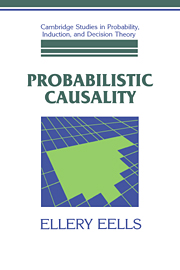Book contents
- Frontmatter
- Contents
- Preface
- Introduction
- Chapter 1 Populations and probability
- Chapter 2 Spurious correlation and probability increase
- Chapter 3 Causal interaction and probability increase
- Chapter 4 Causal intermediaries and transitivity
- Chapter 5 Temporal priority, asymmetry, and some comparisons
- Chapter 6 Token-level probabilistic causation
- Appendix 1 Logic
- Appendix 2 Probabilit
- Bibliography
- Index
Chapter 3 - Causal interaction and probability increase
Published online by Cambridge University Press: 07 October 2009
- Frontmatter
- Contents
- Preface
- Introduction
- Chapter 1 Populations and probability
- Chapter 2 Spurious correlation and probability increase
- Chapter 3 Causal interaction and probability increase
- Chapter 4 Causal intermediaries and transitivity
- Chapter 5 Temporal priority, asymmetry, and some comparisons
- Chapter 6 Token-level probabilistic causation
- Appendix 1 Logic
- Appendix 2 Probabilit
- Bibliography
- Index
Summary
For the examples of spurious correlation discussed in Chapter 2, it sufficed to hold fixed all (independent) positive, negative, and mixed causes of the candidate effect factor, in order for the probability-increase idea to deliver the right answers about what caused what. For these examples, only factors that were causally relevant to the candidate effect factor needed to be held fixed. In this chapter, I will argue that other kinds of factors, which may be causally irrelevant to (neutral for) the effect factor in question, must be held fixed as well, if the probability-increase theory is to deliver the right answers in other kinds of cases.
For example, if the right answer in Dupré's example, discussed in Chapter 2, is that smoking has a mixed causal role (not positive, negative, or neutral) for lung cancer, then it will be necessary to hold fixed the factor of that rare physiological condition. Otherwise, causal relevance would go by average probabilistic impact of smoking on lung cancer, across the presence and absence of that condition, and this cannot give the correct answer of mixed causal relevance. However, as noted in Chapter 2 and explained more fully in this chapter, that physiological condition need not itself be a positive, negative, or mixed cause of lung cancer.
At the beginning of Chapter 2, the possibility of there being such factors as that physiological condition in Dupré's example was called the problem of causal interaction.
- Type
- Chapter
- Information
- Probabilistic Causality , pp. 127 - 168Publisher: Cambridge University PressPrint publication year: 1991

